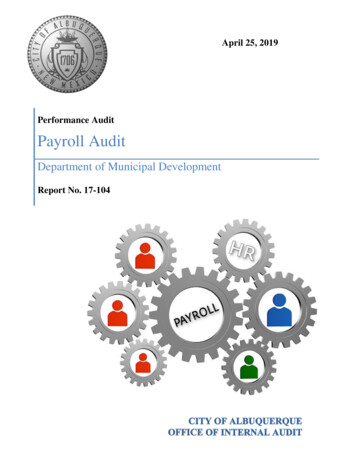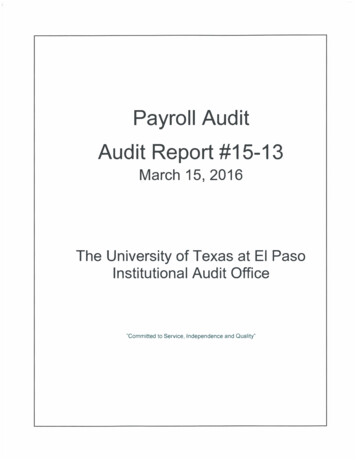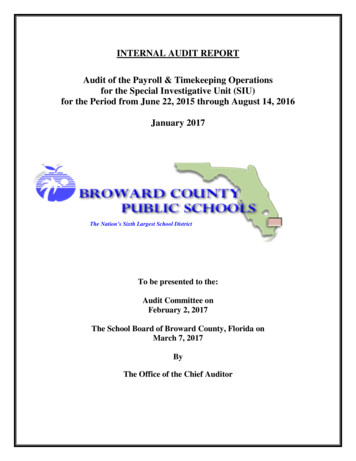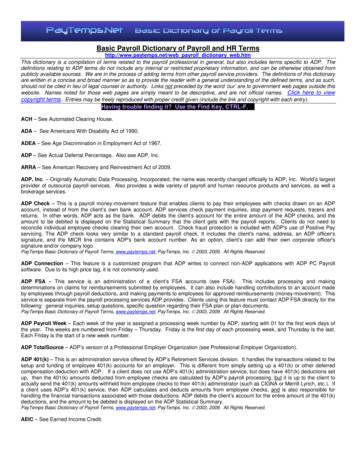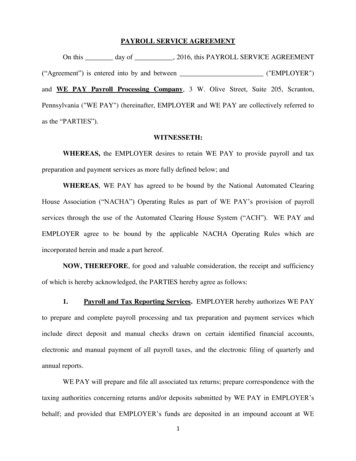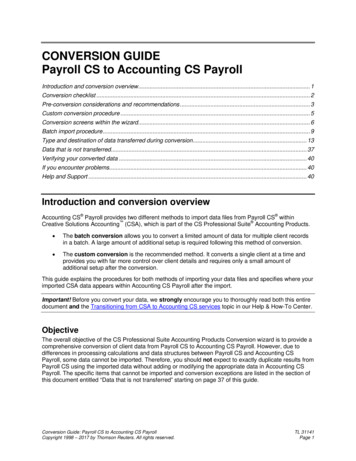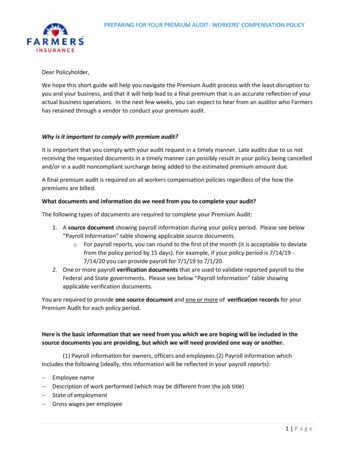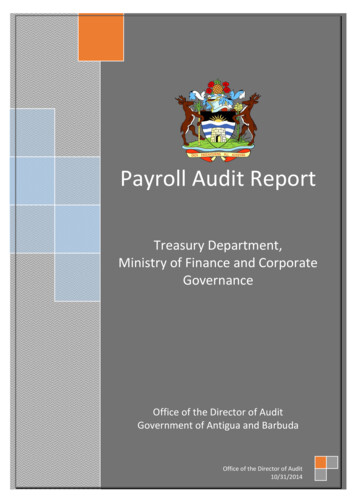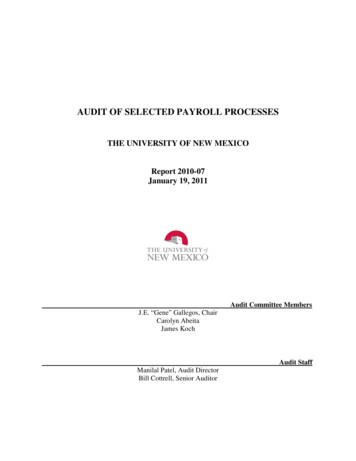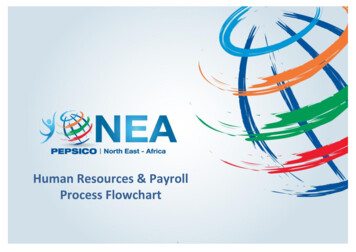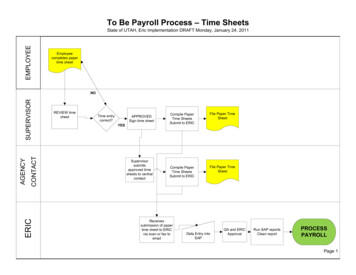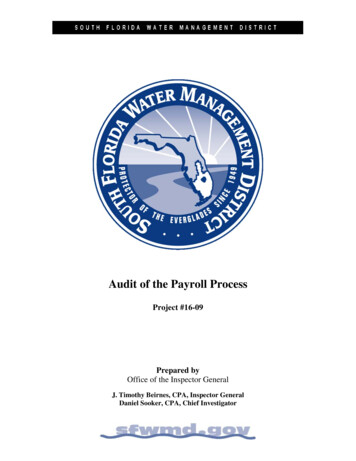
Transcription
Audit of the Payroll ProcessProject #16-09Prepared byOffice of the Inspector GeneralJ. Timothy Beirnes, CPA, Inspector GeneralDaniel Sooker, CPA, Chief Investigator
TABLE OF CONTENTSBACKGROUND . 1OBJECTIVE, SCOPE, AND METHODOLOGY . 2AUDIT RESULTS . 3Executive Summary .3Strengthen Internal Controls over Payroll Processing.5Time Administrator and SupervisoryReview of Timesheets Needs Improvement .7Improvements are Needed to EliminateTimesheet Activity Coding Errors .9Payroll Testing for Fictitious Employees .10APPENDIX 1 – Flowchart of Payroll Time Entry and Process Approval .11Office of Inspector GeneralPage iAudit of the Payroll Process
BACKGROUNDIn accordance with our FY 2016 Audit Plan, our Office conducted an Audit of the PayrollProcess. The District disburses approximately 150 million annually for salaries and benefits,which represents approximately 20% of its annual expenditures. Payroll is administered by theHuman Resource Information System and Payroll Services Unit (HRIS), which consists of fiveemployees, who process the bi-weekly payroll for approximately 1,370 employees. Payrollprocessing is very time sensitive; HRIS staff have a very short timeframe to process employeetimesheets, correct errors, and complete payroll.The District has established internal controls over the payroll process to ensure that payrollis processed accurately, timely, and in accordance with applicable laws and policies andprocedures. Payroll is processed through the District’s SAP Human Capital Management efitsAdministration,PersonnelAdministration, Time Management, Travel Administration, and Training and EventsManagement.Office of Inspector GeneralPage 1Audit of the Payroll Process
OBJECTIVES, SCOPE, AND METHODOLOGYOur objective was to determine whether the payroll process provides for adequatesegregation of duties and that established internal controls over the payroll process are functioningas designed. To accomplish our objectives, we performed the following: Reviewed flowcharts and other documentation regarding internal controls over thepayroll process. Reviewed SAP payroll interfaces. Conducted tests of payroll records to ensure transactions are properly authorized,approved and accurate. Traced payroll information to source documents including pay rate approvals andbenefits.We conducted this performance audit in accordance with generally accepted governmentauditing standards. Those standards require that we plan and perform the audit to obtain sufficient,appropriate evidence to provide a reasonable basis for our findings and conclusions based on ouraudit objectives. We believe that the evidence obtained provides a reasonable basis for ourfindings and conclusions based on our audit objectives.Office of Inspector GeneralPage 2Audit of the Payroll Process
AUDIT RESULTSExecutive SummaryOverall, HRIS does an effective job of processing the bi-weekly payroll within themandated timeframe and often under challenging circumstances. However, our review of thepayroll process revealed internal control weaknesses related to the lack of segregation of dutieswith the HRIS employees who are responsible for payroll processing. The Supervisor hasunrestricted access to all of the components within the Human Capital Management module inSAP. These components include Organizational Management, Benefits, Personnel and TravelAdministration, as well as Time Management, and Training and Events Management. The HRISteam, consisting of a Supervisor and four Analysts, have the various levels of authority to changetimesheet, benefits and payroll records (see table on Page 5 for approval authority details).This level of authority enables the HRIS Supervisor and staff to both initiate and executetimesheet and payroll transactions autonomously, which result in a lack of segregation of dutiesand an internal control weakness. For example, the Supervisor and a HRIS staff have the authorityto add new employees and remove separating employees in the SAP Human Capital Managementmodule. This approval authority is necessary to ensure that payroll is processed and errors arecorrected in a timely manner but compensating controls should be implemented to reduce the risksassociated with this control weakness. Thus, to strengthen internal control over the payroll processand compensate for this weakness, we recommend that any changes to payroll records made bythe HRIS Supervisor and other authorized staff should be recorded in an exceptions report andreviewed by the Human Resources Bureau Chief.Employee supervisors and managers are responsible for timesheet approvals and adherenceto District policies and procedures. We noted various errors and warnings resulting from employeetime sheet input that causes inefficiencies and unnecessarily delays completion of the payrollprocessing. Good internal controls would require time approval managers to routinely review theaudit report that is run every payroll for errors or warnings related to their employees before timeis approved. Accordingly, we recommend that managers and supervisors routinely conduct sucha review.We conducted an audit test to verify that all employees included in the SAP payroll registerare bono fide employees by comparing employees recorded in the SAP payroll register to those inOffice of Inspector GeneralPage 3Audit of the Payroll Process
the District’s Honeywell Win-Pak standalone ID card database. Our comparison of employeesincluded in the SAP payroll register to those in the District’s Honeywell Win-Pak standalone IDcard database revealed no fictitious employees.Office of Inspector GeneralPage 4Audit of the Payroll Process
Strengthen Internal Controls over Payroll ProcessingA prerequisite to a good system of internal controls is maintaining adequate segregation ofduties between employees so that no one employee or small group of employees have completecontrol over a particular financial transaction from beginning to end. Good internal controls overthe payroll processing function ensures that one employee is not in a position to initiate, approveand execute transactions and then periodically review and reconcile recorded amounts. Our reviewof internal controls over the payroll process indicated a lack of adequate segregation of duties,which results in an internal control weakness.The payroll process starts with employees or time administrators completing timesheetsfor the recent two week period using SAP’s Employee Self Service (ESS) or the Cross-ApplicationTimesheet (CAT2). ESS is a web based portal that employees can access from the District’s portalpage to complete their timesheets. CAT2 can be utilized by employees and certain administrativeemployees who are designated as time administrators to complete timesheets for employees intheir section. After timesheets are completed, they are released in SAP for supervisory approval.Most often, approval is performed by the employee’s immediate supervisor but the Bureau Chief,or Division Director within their organizational hierarchy can also approve employee timeprovided they are authorized time approvers in SAP. (See Appendix 1 for Time Entry andApproval Process flowchart).The HRIS team consists of one supervisor and four analysts. The Supervisor hasunrestricted access to all of the components within the Human Capital Management module inSAP. These components include Organizational Management, Benefits, Personnel and TravelAdministration, as well as Time Management, and Training and Events Management. Both theSupervisor and HR Analysts have various levels of authority to change timesheets, payroll recordsand benefits as noted in the following table:Human Resource ProcessingActivitiesOn-board New EmployeesOff-board Separating EmployeesImplement Salary ChangesChange Timesheets and PayrollRecordsChange Employee BenefitsOffice of Inspector HRISAnalystHRISAnalystXXXXPage 5Audit of the Payroll Process
The HRIS Supervisor and Analysts processing authority is essential to ensure that payrollchanges are made and errors are corrected in a timely manner. Without the authority to originate,approve and/or change payroll records, payroll processing could be unreasonably delayed anddeadlines missed. In the last 18 months, there has been a 75% turnover of HRIS Analysts, whichresulted in the HRIS Supervisor stepping in to enter new hires, benefits and execute the payroll.However, this level of authority enables the HRIS Supervisor and other authorized staff to bothprepare and process payroll, which are incompatible functions1 that result in a lack of segregationof duties and an internal control weakness.When there is a lack of adequate segregation of duties with any process, compensatinginternal controls should be implemented to mitigate the risks related to the existing controlweakness. Accordingly, we recommend that any changes to payroll records made by the HRISSupervisor and/or the four other authorized staff should be reported in an exceptions report andreviewed by the Human Resource Bureau Chief.Recommendation1. All changes made to payroll records by the HRIS Supervisor and staff should bereviewed by the Human Resources Bureau Chief as a compensating control for theinsufficient segregation of duties.Management Response: Agree. The Human Resources Bureau will utilize the existingSAP exception report that captures any activity performed in the payroll module. TheBureau Chief will review the HRIS Supervisor’s changes captured on the exception report.Responsible Division: Human Resources Bureau - Administrative ServicesEstimated Completion Date: Complete1Incompatible functions is a concept of segregation of duties that is defined as job duties that place an employee ordepartment in a position to initiate, approve and execute transactions.Office of Inspector GeneralPage 6Audit of the Payroll Process
Time Administrator and Supervisory Review ofTimesheets Needs ImprovementA key component of a good internal controls system is adherence to policies andprocedures. To determine employee compliance with policies and procedures related to payroll,we reviewed 50 employee records, which included timesheets from FY 2015 through FY 2016,approved pay rate documents and other personnel records. Our sample consisted of all HRIS staff,randomly selected employees, and a sample of employees that were reported on the August 3,2016, payroll audit report as containing errors or warnings. Our testing was designed to determinewhether: employees were paid in accordance with payroll policies and procedures. the hours worked and the leave taken on the timesheet agreed to the pay statement. employee’s supervisors properly approved the timesheet. the pay rate reported on the pay statement agreed with signed documents approving therate in the employee’s personnel file.HRIS is responsible for executing payroll based on the time manager or supervisorapproval of employee timesheets. Employee supervisor and managers are responsible forapproving timesheets and ensuring compliance with policies and procedures. Based on our review,we found various errors and warnings resulting from employee timesheet input that included acompensatory time error and for a number of employees no timesheet data was submitted.We found that certain payroll internal control procedures were in place to alert timeapprovers of these issues. Every pay period the SAP Human Capital Management modulegenerates an error and warning audit report, which indicates the employee name, employeenumber, type of error or warning, exempt or non-exempt status. For example, when an employeeworks over 80 hours the report includes a warning message to alert the employee’s supervisor ortime administrator of a potential issue. Also, a warning was included for employees in which lessthan 80 hours for a pay period was recorded on their timesheet. Good internal controls wouldrequire time approval managers to review the audit report every payroll for errors or warnings oftheir employees.Had these reports been reviewed by employee supervisors and timeOffice of Inspector GeneralPage 7Audit of the Payroll Process
administrators, payroll errors could have been identified and resolved. Further, these unattendederrors and warnings delay the processing of payroll.Our testing also uncovered a timesheet correction that was processed by a Human ResourceAnalyst but not approved by the employee’s supervisor. The Human Resource Analyst correcteda timesheet input error and attempted to contact the employee’s supervisor to inform him of thechange and obtain his approval. However, the supervisor was not available and in order to keepthe payroll process moving forward the Human Resource Analyst processed the correctedemployee’s timesheet. Further review revealed that the supervisor did not approved the timesheet.Good internal control procedures include supervisory approval of timesheets even if it is afterpayroll processing is complete. Corrections can be made in subsequent pay periods if needed.Recommendation2. Require time approval managers to review the payroll audit report for errors orwarnings related to their employees as soon as the report becomes available topromptly resolve any time input errors.Provide audit report training for timeapproval managers as deemed necessary.Management Response: Agree. The Human Resources Bureau will provide payroll timeentry and approval guidelines to the Executive Team for discussion and approval. Onceapproved, the guidelines will be provided to all time approvers.Responsible Division: Human Resources Bureau - Administrative ServicesEstimated Completion Date: April 27, 2017Office of Inspector GeneralPage 8Audit of the Payroll Process
Improvements are Needed to EliminateTimesheet Activity Coding ErrorsWhen employees work on certain projects and maintenance activities, they are required topost their time to project activity codes that are generated by the project manager to account forproject cost in SAP’s Project Systems module. The project activity codes are used to track andaccumulate internal labor and other costs related to specific project tasks. Generally, these projectcosts are recorded to document the District’s effort related to environmental restoration and othercost-sharing projects with state and federal partners. For cost share projects with the United StatesArmy Corps of Engineers, the District may be eligible to receive in-kind credit for labor hoursincurred and land costs related to CERP activities. For field station staff performing plantmaintenance activities, including equipment preventive maintenance, structure, canal and leveemaintenance activities, labor hours and other costs incurred on these maintenance activities areposted to internal orders. Employee supervisors are responsible for approving time and the activitycoding posted to employee timesheet.HRIS reported that on average from 6 to 10 employees post their time to invalid activitycodes every pay period, which causes the payroll process to completely stop until the input errorsare corrected. These coding errors result in inefficiencies and needlessly delay completion of thepayroll processing. Generally, correcting coding errors requires input from HRIS staff, Budgetstaff, project managers and the employee’s supervisor. The SAP Software Services is currentlyworking on the coding error problem but a solution has not yet been finalized and implemented.Recommendation3. Finalize solution to resolve invalid payroll activity coding errors.Management Response: Agree. An automated email will be sent every two weeks priorto timesheet approval time. The email will be sent from SAP Project Systems to the ProjectManager’s and the Fund Center Responsible person with activity id, name, work center,planned hours, actual hours, and physical percentage complete. The information providedwill help to ensure that correct activity codes are entered.Responsible Division: Metrics Bureau - Administrative Services,Estimated Completion Date: December 31, 2017Office of Inspector GeneralPage 9Audit of the Payroll Process
Payroll Testing for Fictitious EmployeesOur audit uncovered internal control weaknesses related to HRIS staff having the authorityto originate, approve and/or change payroll records including onboard new employees, off boardseparating employees, process salary changes, modify time entries and set up employeegarnishments. Accordingly, to mitigate this weakness we designed an audit procedure to verifythat all employees included in the SAP payroll register are bono fide employees by comparingemployees recorded in the SAP payroll register to those in the District’s Honeywell Win-Pakstandalone ID card database The Honeywell Win-Pak is a standalone software package to controlaccess to District facilities, which is maintained by the District’s Facility and Security Unit. TheDistrict requires all employees to obtain a picture identification badge (ID badge) from the Facilityand Security Unit and carry it at all times when at District facilities. Entrance to District buildingsand elevators requires an ID badge.Because the Honeywell Win-Pak is a standalone system and all employees are required tohave a picture ID badge, it is an independent system separate from the SAP Human CapitalManagement module, which includes all components of payroll. Our comparison of employeesincluded in the SAP payroll register to those in the District’s Honeywell Win-Pak standalone IDcard database revealed no fictitious employees.Office of Inspector GeneralPage 10Audit of the Payroll Process
Flowchart of Payroll Time Entry and Process ApprovalEmployeeTime AdministratorChief Time ApproverReview time workedand approved leavetakenStartEnter time inEmployee Self ServiceNoAre therewarningsor errorsYesAssist withcorrecting timeentry issuesReview and correcttimeNotify TimeAdministrator thattimesheet is readyfor processingRun display worktime reportReconcile work andleave timeRun timesheet auditreportNoIs the timeentry correctYesNotify timeapprover that entryis completeReceive notificationtime is ready forapproval and reviewEnter approve worktime transaction inSAPGo to PayrollProcessOffice of Inspector GeneralAppendix 1Page 11Audit of the Payroll ProcessEnd
APPENDIX 1 – Flowchart of Payroll Time Entry and Process Approval . The payroll process starts with employees or time administrators completing timesheets for the recent two week period using SAP’s Employ ee Self Service (ESS) or the Cross-Application Timesheet (CAT2). ESS is a web bas
